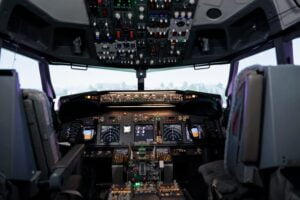A crucial cornerstone of modern aviation technology, ARINC (Aeronautical Radio, Incorporated) plays a pivotal role in shaping the efficiency, safety, and reliability of aircraft systems.
Initially established in 1929 as a provider of radio communications for the aviation industry, ARINC has evolved over the decades to become a leading standards-setting organization, offering a wide array of protocols, systems, and solutions tailored to the unique needs of the aerospace sector.
A. Definition and Origin
ARINC, founded by the early pioneers of aviation, emerged in response to the burgeoning demand for reliable communication systems within the rapidly expanding aviation industry.
Initially formed as a cooperative venture among major airlines, ARINC aimed to standardize radio equipment and communication procedures, thereby enhancing interoperability and safety across the aviation network.
Over time, ARINC’s scope expanded beyond radio communications to encompass a diverse range of avionics, data protocols, and systems crucial for modern aircraft operations.
B. Importance in the Aviation Industry
In today’s aviation landscape, ARINC stands as a cornerstone of technological innovation and standardization, playing a fundamental role in virtually every aspect of aircraft design, operation, and maintenance.
From avionics systems to communication protocols, ARINC’s standards and solutions permeate the fabric of modern aviation, facilitating seamless integration, interoperability, and data exchange across diverse aircraft platforms.
C. Evolution of ARINC Standards
The evolution of ARINC standards mirrors the rapid advancement of aviation technology and the ever-expanding complexity of aircraft systems.
From its early days of radio communications to the present era of digital avionics and data-centric operations, ARINC has continually adapted and innovated to meet the evolving needs of the aerospace industry.
Today, ARINC standards serve as the bedrock upon which modern aircraft systems are built, providing a common language and framework for manufacturers, operators, and service providers alike.
In the subsequent sections, we delve deeper into the intricacies of ARINC standards, communication protocols, avionics systems, and their applications in contemporary aviation.
Through this exploration, we aim to elucidate the significance of ARINC in shaping the past, present, and future of aviation technology.

ARINC Standards
ARINC standards form the backbone of modern aviation technology, providing a common framework and set of guidelines for the design, implementation, and operation of aircraft systems.
These standards encompass a wide range of domains, including communication protocols, data formats, avionics systems, and interfaces, serving to enhance interoperability, reliability, and safety across the aerospace industry.
A. Overview of ARINC Standards
ARINC standards are developed and maintained by ARINC Industry Activities (AIA), a division of AEEC (Airlines Electronic Engineering Committee).
AIA comprises representatives from airlines, avionics manufacturers, regulatory authorities, and other stakeholders, who collaborate to establish consensus-based standards that address the diverse needs of the aviation community.
The scope of ARINC standards is vast, covering various aspects of aircraft communication, navigation, surveillance, and maintenance.
These standards undergo rigorous review, revision, and approval processes to ensure relevance, compatibility, and compliance with regulatory requirements and industry best practices.
B. Key ARINC Standards and their Functions
ARINC 429: A widely used standard for digital data communication between avionics systems, ARINC 429 defines the electrical and protocol specifications for transmitting data between aircraft systems, such as flight management computers, navigation systems, and cockpit displays.
ARINC 708: This standard pertains to weather radar systems used for airborne weather detection and avoidance. It specifies the interface requirements and data formats for weather radar equipment installed on aircraft.
ARINC 717: Designed for digital flight data recorders (DFDRs), ARINC 717 standardizes the recording and storage of flight data, including aircraft parameters, cockpit audio, and other critical information essential for post-flight analysis and investigation.
ARINC 818: A protocol standard for high-speed video transmission in avionics systems, ARINC 818 facilitates the display of video imagery on cockpit displays, head-up displays, and other aircraft avionics equipment with minimal latency and high reliability.
ARINC 825: Also known as the CAN (Controller Area Network) bus standard for avionics applications, ARINC 825 defines the communication protocol and physical layer requirements for data exchange between avionics systems via a CAN bus network.
ARINC 834: This standard specifies the interface requirements for aircraft traffic surveillance systems, such as Mode S transponders and ADS-B (Automatic Dependent Surveillance-Broadcast) equipment, enabling the exchange of aircraft position and identification data for air traffic management purposes.
ARINC 836: Addressing the need for standardized data loading procedures in avionics systems, ARINC 836 defines the protocols, formats, and interfaces for loading software, databases, and configuration data into aircraft avionics equipment.
ARINC 825: Standard for avionics network technology based on Ethernet, ARINC 825 (formerly ARINC 664 Part 7) defines the specifications for implementing switched Ethernet networks in aircraft systems, providing high-speed, deterministic communication for mission-critical applications.
These key ARINC standards represent just a fraction of the comprehensive suite of standards developed by ARINC to support the diverse needs of the aviation industry.
In the subsequent sections, we delve deeper into the applications and significance of these standards in enhancing the safety, efficiency, and capabilities of modern aircraft systems
ARINC Communication Protocols

ARINC (Aeronautical Radio, Incorporated) communication protocols play a crucial role in facilitating communication and data exchange within aviation systems.
These protocols are specifically designed to meet the demanding requirements of the aerospace industry, ensuring reliable and efficient communication between various avionics systems and components.
Let’s delve into some of the prominent ARINC communication protocols:
A. ARINC 429 Protocol:
Structure and Format:
- ARINC 429 is a two-wire, point-to-point data bus standard widely used in commercial and transport aircraft.
- It operates at a standard data rate of either 12.5 or 100 kilobits per second.
- Data on the ARINC 429 bus is transmitted serially in 32-bit words, consisting of a label, a 24-bit data field, a parity bit, and a sync bit.
Application in Aircraft Systems:
- ARINC 429 is extensively used for transmitting various types of data, including flight control parameters, navigation information, engine data, and avionics system status.
- It facilitates communication between avionics systems such as flight management systems, autopilots, weather radars, and display units.
- The protocol’s robustness and reliability make it ideal for critical aircraft functions where real-time data exchange is essential.
B. ARINC 629 Protocol:
Overview and Purpose:
- ARINC 629 is a multi-transmitter, dual-receiver protocol designed to provide high-speed data communication within aircraft systems.
- It operates on a twisted-pair cable network, allowing for simultaneous communication between multiple avionics systems.
- The protocol was primarily developed to support advanced digital flight control systems and aircraft with fly-by-wire technology.
Advantages and Limitations:
- Advantages include high-speed data transmission (up to 2 Mbps), fault tolerance, and deterministic behavior.
- However, the implementation complexity and limited scalability of ARINC 629 have led to its gradual replacement by newer protocols such as AFDX (ARINC 664).
C. ARINC 664 Protocol:
Introduction to AFDX (Avionics Full-Duplex Switched Ethernet):
- AFDX is a modern avionics data network standard based on switched Ethernet technology.
- It offers high-speed, deterministic communication suitable for time-critical applications in modern aircraft.
- AFDX provides guaranteed quality of service (QoS), redundancy, and fault tolerance, making it well-suited for critical avionics systems.
Implementation and Benefits:
- AFDX is increasingly being adopted in next-generation aircraft for communication between avionics systems, including flight control, navigation, and entertainment systems.
- Its benefits include reduced wiring complexity, increased bandwidth, improved scalability, and support for integrated modular avionics (IMA) architectures.
These ARINC communication protocols form the backbone of data exchange in modern aircraft, ensuring safe, reliable, and efficient operation in both commercial and military aviation contexts.
ARINC Data Loading
ARINC data loading is a crucial process in aviation that involves the transfer of software, configuration data, flight plans, and other operational information to aircraft avionics systems. This method enables airlines and operators to efficiently update and manage the software and data onboard aircraft, ensuring compliance with regulatory requirements and enhancing operational efficiency. Here, we delve into the various aspects of ARINC data loading:
Definition and Significance:
- ARINC data loading refers to the process of transferring data and software configurations to avionics systems using standardized protocols and interfaces developed by ARINC.
- This method is essential for updating flight management systems (FMS), navigation databases, terrain databases, and other critical software components onboard modern aircraft.
ARINC 615 Protocol:
The ARINC 615 protocol is a widely used standard for data-loading operations.
It defines the communication protocols and data formats for loading software parts, configuration data, and other information onto avionics systems.
ARINC 615 encompasses various capabilities such as file transfer, database loading, and software part management.
Implementation in Aircraft Systems:
- ARINC 615 data loading is typically facilitated through specialized ground support equipment (GSE) connected to the aircraft via ARINC 429 or Ethernet interfaces.
- Aircraft maintenance personnel and avionics technicians utilize dedicated software applications to manage the data-loading process.
- The process involves verifying data integrity, performing security checks, and ensuring compatibility with the aircraft’s avionics systems.
Advantages of ARINC Data Loading:
- Efficiency: ARINC data loading streamlines the process of updating software and configuration data, reducing downtime and minimizing operational disruptions.
- Accuracy: By using standardized protocols and interfaces, ARINC data loading ensures the accurate transfer of information without errors or inconsistencies.
- Compliance: Airlines can easily comply with regulatory requirements for software updates and database revisions by employing ARINC data-loading solutions.
- Flexibility: The modular nature of ARINC data loading systems allows for the customization of software configurations and the integration of new features as per operational needs.
In essence, ARINC data loading plays a vital role in maintaining the airworthiness and operational readiness of aircraft avionics systems. Its standardized protocols and efficient procedures contribute to safe and reliable flight operations in the dynamic aviation industry.
ARINC Avionics Systems
ARINC avionics systems represent a comprehensive suite of integrated systems and components crucial for the operation, navigation, communication, and safety of aircraft. Developed and standardized by ARINC, these systems play a pivotal role in modern aviation. Here’s an in-depth look at ARINC avionics systems:
Introduction to ARINC Avionics Systems:
ARINC avionics systems encompass a wide array of electronic systems and components designed to ensure the safe and efficient operation of aircraft.
These systems are built to comply with ARINC standards, which dictate the design, communication protocols, and interfaces for avionics equipment.
Avionics Systems and Components:
Flight Management Systems (FMS):
- FMS integrates various subsystems such as navigation, autopilot, and performance management to optimize flight operations.
- It facilitates route planning, navigation, and automatic control of the aircraft.
Communication Systems:
- ARINC communication systems enable voice and data communication between aircraft and ground stations, air traffic control, and other aircraft.
- These systems utilize protocols like VHF, HF, SATCOM, and CPDLC (Controller-Pilot Data Link Communication) to ensure reliable communication.
Navigation Systems:
- ARINC navigation systems include GPS (Global Positioning System), VOR (VHF Omni-directional Range), and IRS (Inertial Reference System).
- These systems provide accurate position information, aiding in navigation, approach, and landing procedures.
Surveillance Systems:
- ARINC surveillance systems encompass radar, ADS-B (Automatic Dependent Surveillance-Broadcast), and TCAS (Traffic Collision Avoidance System).
- They enhance situational awareness, detect other aircraft, and provide collision avoidance advisories.
Integration of ARINC Avionics Systems in Aircraft:
- ARINC avionics systems are seamlessly integrated into various aircraft types, including commercial airliners, business jets, and military aircraft.
- Aircraft manufacturers incorporate ARINC-compliant systems during the design and production phase, ensuring compatibility and interoperability.
- Integration involves rigorous testing, certification, and validation to meet regulatory requirements and ensure safe and reliable operation.
- ARINC avionics systems are fundamental to the operation of modern aircraft, providing pilots with the necessary tools and information to navigate safely, communicate effectively, and maintain situational awareness.
- Their adherence to standardized protocols and interfaces ensures interoperability and compatibility across different aircraft platforms, contributing to the overall safety and efficiency of air travel.
Future Trends and Developments in ARINC
As the aviation industry continues to evolve, so do the technologies and standards associated with ARINC. Looking ahead, several trends and developments are shaping the future of ARINC, influencing its standards, protocols, and applications. Here’s an exploration of some key trends and developments:
Advancements in ARINC Standards:
- ARINC standards are continually updated and refined to keep pace with technological advancements and industry requirements.
- Future developments may focus on enhancing data exchange capabilities, improving cybersecurity measures, and integrating emerging technologies such as artificial intelligence (AI) and machine learning (ML).
- Efforts to standardize new avionics interfaces and protocols for next-generation aircraft platforms, including electric and hybrid-electric aircraft, may also drive future ARINC standardization efforts.
Integration of ARINC with Next-Generation Aircraft:
- Next-generation aircraft, including urban air mobility (UAM) vehicles and supersonic transports, are expected to rely heavily on ARINC-compliant avionics systems.
- ARINC standards will play a critical role in ensuring interoperability and compatibility across diverse aircraft platforms, supporting seamless communication, navigation, and surveillance capabilities.
- Integration challenges related to the complexity of future aircraft architectures, including distributed systems and fly-by-wire controls, may drive the development of new ARINC standards and protocols.
Emerging Technologies and Their Impact on ARINC:
- Emerging technologies such as augmented reality (AR), virtual reality (VR), and wearable devices are poised to revolutionize cockpit displays and pilot interfaces.
- ARINC standards may evolve to accommodate the integration of these technologies, providing guidelines for the design and implementation of advanced cockpit systems.
- Additionally, the proliferation of unmanned aerial vehicles (UAVs) and autonomous aircraft is likely to drive the development of ARINC standards for unmanned systems, addressing unique communication, navigation, and control requirements.
Cybersecurity and Data Protection:
- With the increasing connectivity of aircraft systems and the growing reliance on data-driven technologies, cybersecurity is a paramount concern.
- Future developments in ARINC may focus on enhancing cybersecurity measures, including encryption standards, intrusion detection systems, and secure data transfer protocols.
- Collaboration with cybersecurity experts and industry stakeholders will be essential to develop robust cybersecurity frameworks that safeguard aircraft systems from cyber threats.
Conclusion
In conclusion, ARINC (Aeronautical Radio, Incorporated) stands as a cornerstone in the aviation industry, providing standardized solutions that underpin the safety, efficiency, and reliability of aircraft operations worldwide. Throughout its history, ARINC has continually evolved, developing robust standards, protocols, and avionics systems that have become integral components of modern aircraft.
The content outlined in this discussion has provided a comprehensive overview of ARINC, covering its communication protocols, data loading mechanisms, avionics systems, and future trends. It is evident that ARINC’s contributions extend beyond mere technological advancements; they have fundamentally transformed the way aircraft communicate, navigate, and operate in the skies.
Looking ahead, the future of ARINC holds immense promise, fueled by ongoing technological innovations and industry collaborations. As aviation embraces next-generation aircraft, digital transformation, and sustainable practices, ARINC will continue to play a pivotal role in shaping the trajectory of aviation.
As we navigate through the complexities of the aviation landscape, it is imperative to recognize the enduring significance of ARINC and its unwavering commitment to excellence, safety, and innovation. By staying at the forefront of technological advancements and industry standards, ARINC will continue to propel aviation forward, ushering in a new era of safer, smarter, and more connected flight operations.
In essence, ARINC’s legacy is not just about the systems it has built but the enduring impact it has had on the aviation ecosystem. As we embrace the future, let us acknowledge ARINC’s pivotal role in shaping the past, present, and future of aviation, and honor its contributions to making air travel safer, more efficient, and more accessible for generations to come.






